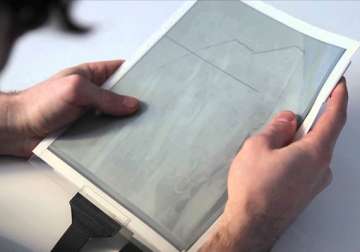New Delhi: Scientists have used a focused beam of electrons to create some of the smallest nanowires ever made, an advance that paves the way for flexible, paper-thin tablets and television displays.
Junhao Lin, a Vanderbilt University student and visiting scientist at Oak Ridge National Laboratory (ORNL), used a finely focused beam of electrons to create the flexible metallic wires only three atoms wide: one thousandth the width of the microscopic wires used to connect the transistors in today's integrated circuits.
According to Lin's advisor Sokrates Pantelides, University Distinguished Professor of Physics and Engineering at Vanderbilt University, and his collaborators at ORNL, the technique represents an exciting new way to manipulate matter at the nanoscale and should give a boost to efforts to create electronic circuits out of atomic monolayers, the thinnest possible form factor for solid objects.
Lin made the tiny wires from a special family of semiconducting materials that naturally form monolayers.
These materials, called transition-metal dichalcogenides (TMDCs), are made by combining the metals molybdenum or tungsten with either sulfur or selenium.
The best-known member of the family is molybdenum disulfide, a common mineral that is used as a solid lubricant.
Atomic monolayers are the object of considerable scientific interest because they tend to have a number of remarkable qualities, such as exceptional strength and flexibility, transparency and high electron mobility.
Other research groups have already created functioning transistors and flash memory gates out of TMDC materials.
So the discovery of how to make wires provides the means for interconnecting these basic elements.
Next to the transistors, wiring is one of the most important parts of an integrated circuit. Although today's integrated circuits (chips) are the size of a thumbnail, they contain more than 32 kms of copper wiring.
"This will likely stimulate a huge research interest in monolayer circuit design," Lin said.
"Because this technique uses electron irradiation, it can in principle be applicable to any kind of electron-based instrument, such as electron-beam lithography," Lin added.
One of the intriguing properties of monolayer circuitry is its toughness and flexibility.
It is too early to predict what kinds of applications it will produce, but "If you let your imagination go, you can envision tablets and television displays that are as thin as a sheet of paper that you can roll up and stuff in your pocket or purse," Pantelides said.
The study included a group headed by Kazu Suenaga at the National Institute of Advanced Industrial Science and Technology in Tsukuba, Japan. Other collaborators at ORNL, the University of Tennessee in Knoxville, Vanderbilt University, and Fisk University contributed to the project.
The study was published in the journal Nature Nanotechnology.
Latest Business News
